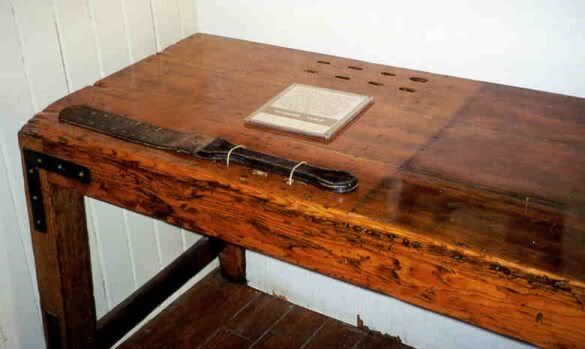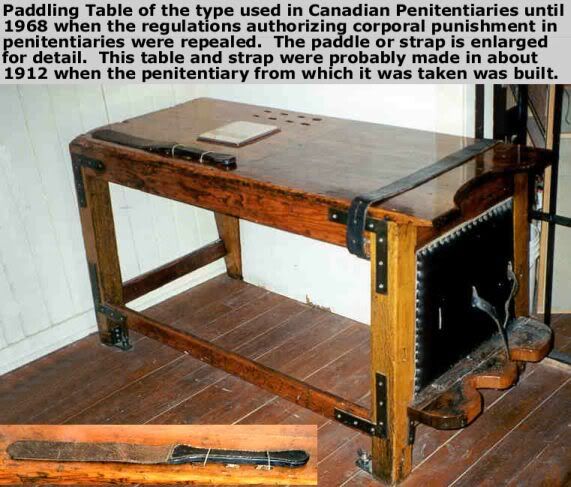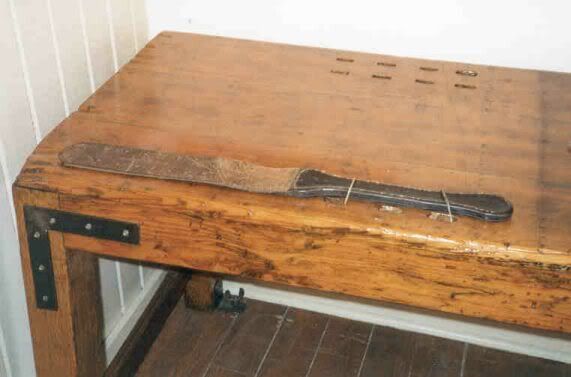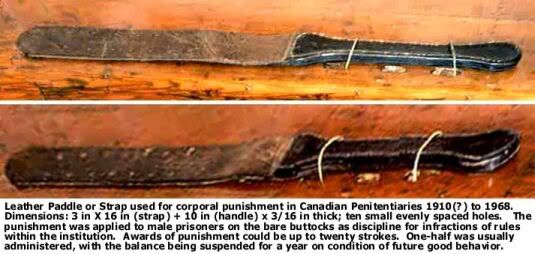We have seen in Part 1 and Part 2 that two different methods were used for administering CP with the strap in Canadian prisons. In federal penitentiary it was applied with the prisoner bending over a table to which he was tied. But in some provincial institutions, such as Guelph Reformatory, where Roger Caron received his two paddlings, the prisoner under punishment was locked in a standing position into a frame called "the machine", described by Caron as "a mass of metal tubing".
"Mr D" in his testimony revealed that he had received both types of strapping and "saw little to choose between the two methods".
Practice was apparently not uniform at provincial institutions, since the youth quoted in the 1951 study refers to being "put into a machine" with "hands and legs clamped so that you are in a bending position".
(A) The penitentiary paddling table
Warden Allan of Kingston Penitentiary described this as his "strapping table", with leather pads on top, and shackles on the lower part for the prisoner's feet. A strap was put over the small of his back and tightened according to the height of the man. At the other end were straps to fasten his hands.
Mr Allan described an "adjustment bar underneath, on both sides" to raise or lower the table according to the prisoner's height.
In a book from an earlier period about Kingston Penitentiary called Shackling the Transgressor: An Indictment of the Canadian Penal System by Oswald C.J. Withrow (Nelson, Toronto, 1933) is the following description by an inmate:
"A large, strong table is brought up from below (it is very like the heavy massage tables used in the hospitals during the war), and the victim is strapped to it. The trousers are lowered and the body is bent at the waist so that the culprit stretches his hands high up on the table and leans over the end. The man's wrists are stretched as far as they will go without pulling the bones from the sockets and tightly strapped; the legs are also stretched and fixed. It is the old rack and thumbscrew brought up-to-date for the Canadian prisons. The torture of this is realistic enough in itself. Around his body is another strap tightly drawn so that the slightest movement is impossible. The man's eyes are blindfolded. He must not see his castigator and besides, things are harder to bear in the darkness.
"The burly guard chosen for this ceremony wields the paddle. Only a few of the guards are selected to do this brutal work. We knew them. They were vicious through and through. It was said that they enjoyed the cruel pastime and that they received extra pay and the balance of the day as a holiday whenever they officiated [...]"
The small picture at left, of a "strapping bench" enclosed in a glass display case, appeared on the website (now apparently disappeared) of the Canada Correctional Services Museum at Kingston Penitentiary. This particular bench may or may not be from Kingston, since the museum contains artefacts from other prisons too.
The caption stated that the bench was used from 1903 to 1968, and continued: "The 'strap' or 'paddle' was applied to the bare buttocks of an inmate who had been sentenced by the 'Warden's Court', usually for the assault of an officer or inmate".
A much clearer picture (below) is now to hand, from a different penitentiary museum, or possibly the same one. This particular contraption shows no sign of being adjustable for height as referred to by Warden Allan. The source of the caption is unknown, but there cannot be much room for doubt that the machine is what it says it is. Also shown is an example of the leather paddle or strap.

(B) The Ontario "machine"
"The Machine" was photographed for the first time at Monteith Industrial Farm. The picture appeared on the front page of the Toronto Telegram on 14 February 1956. This is evidently very similar to, if not identical with, the contraption at Guelph into which Roger Caron described being "securely anchored in an upright position", "naked from head to foot".
Since this photocopy from microfilm of the newspaper photo is of poor quality, a reader who is a designer has kindly produced a computer-generated version of the image (left).
Another reader has generously offered a coloured reproduction of the design (right), though of course we can only guess at the actual colours.
We can now clearly see what Caron meant by his expression "a mass of metal tubing contoured to embrace a human form and, affixed to it, shackles and restraining straps".
The Telegram, under the heading "Strap Machine Seldom Used" (only "once or twice a year" at Monteith), described it as "a twisted mass of iron and leather", continuing: "Prisoner's hands are manacled at top, the belt is pulled tight around his waist, his legs and feet are bolted with iron".
We see the shackles near ground level for the ankles, and another pair of shackles at knee level. Above that, the band to encircle the waist; and at the top, back near the wall, a pair of manacles for the wrists. Caron stated: "My arms were pulled out straight ahead of me and cuffed".
It is interesting to note that this device offers no support for the abdomen itself, i.e. on the opposite side of the prisoner's body to the place (the posterior) where the strap actually lands.
(C) The strap itself
The above picture is from the penitentiary museum referred to earlier. The source of the caption is unknown.
The picture at left appeared in Canadian Welfare magazine, issue 44 (July-August 1968), in an anti-CP article by the director of the John Howard Society. The caption reads: "The 'paddle' or strap used in Canadian penitentiaries [...] is perforated, so that the soft flesh of a man's buttocks is drawn up and torn with each stroke. He usually can't take more than a few strokes at a time." Warden Allan of Kingston Penitentiary had a more innocent, aerodynamics-related explanation for the holes, to do with keeping the strap flat so that it did not turn and cut the prisoner.
The photograph tallies with Warden Allan's description: "The strap consists of a piece of sole leather 16 inches long by 2½ inches wide, with a leather handle which is approximately 10 inches long. In the body of the strap there are 8 holes of approximately one-quarter inch diameter, spread at even intervals." Notice the embossed seal of the federal penitentiaries administration.



